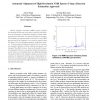Free Online Productivity Tools
i2Speak
i2Symbol
i2OCR
iTex2Img
iWeb2Print
iWeb2Shot
i2Type
iPdf2Split
iPdf2Merge
i2Bopomofo
i2Arabic
i2Style
i2Image
i2PDF
iLatex2Rtf
Sci2ools
87
Voted
ICPR
2006
IEEE
2006
IEEE
Automatic Alignment of High-Resolution NMR Spectra Using a Bayesian Estimation Approach
Nuclear magnetic resonance (NMR) spectral analysis has recently become one of the major means for the detection and recognition of metabolic changes of disease state, physiological alteration, and natural biological variation. For the pattern recognition tasks in which two or more NMR spectra need to be compared, it is critical to properly align the spectra for the subsequent pattern recognition analysis. Previous spectral alignment methods do not consider any baseline intensity variation between the spectra and disregard the effect of noise. Here we formulate the spectra alignment problem in a Bayesian statistical framework, which allows us to simultaneously and efficiently estimate the spectral shift and the baseline intensity variation in the existence of independent additive noise. Experimental results with real high-resolution NMR spectral data from human plasma demonstrate the effectiveness and robustness of the proposed approach.
Baseline Intensity Variation | Computer Vision | ICPR 2006 | NMR Spectral Data | Spectra Alignment Problem |
Related Content
| Added | 09 Nov 2009 |
| Updated | 09 Nov 2009 |
| Type | Conference |
| Year | 2006 |
| Where | ICPR |
| Authors | Seoung Bum Kim, Zhou Wang |
Comments (0)

